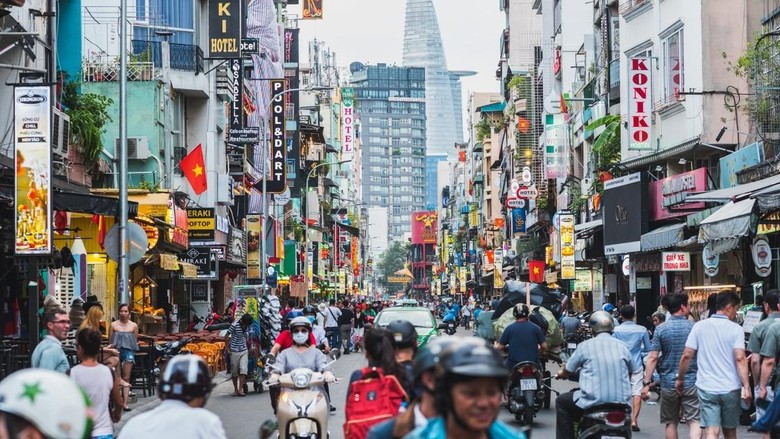
● Gross Merchandise Value (GMV) is projected to grow by 28% to US$23 billion in 2022, up from US$18 billion in 2021, bolstered by a 26% YoY growth in e-commerce
● Fastest Growing eCommerce Sector in SEA in 2022 (26% CAGR)
● Tops venture capital's (VC) long term growth markets - 83% of VCs expect deal activity in Vietnam to grow in the long term (highest in SEA)
Google, Temasek and Bain & Company released the seventh edition of the eConomy Southeast Asia (SEA) report - Through the waves, towards a sea of opportunity, today. The report shares an update on how digital economy sectors are tracking across six countries - Indonesia, Malaysia, the Philippines, Singapore, Thailand and Vietnam. This year, the report ranks Vietnam as the fastest growing digital eConomy in SEA in 2022 with projected GMV to grow by 28% to US$23 billion, up from US$18 billion in 2021, bolstered by a 26% YoY growth in e-commerce.
Post the pandemic, Vietnam is among the countries that are on the fast track to resume its ‘back to normal' activities. However, some consumer habits and trends that were built and accelerated during the pandemic have remained and continued to grow. E-commerce is the key driver for the growth of Vietnam's digital economy and 90% of digital consumers intend to maintain or even further their usage of e-commerce platforms in the next 12 months. Majority of consumers who plan to maintain the same usage across food delivery (60%) and groceries (54%).
Urban digital users are the heaviest adopters of digital services in Vietnam, with e-commerce, food and groceries having the highest adoption rates - 96%, 85% and 85% respectively. On the other hand, Vietnamese consume online media content less frequently than what the regional average is. Video, music and gaming consumption are all 10-12% below the average consumption. 23% of people said they watched video on demand at least once a week, followed by 19% for gaming and on demand and 16% for music. This also shows that Vietnam still has great potential for substantial growth in the long run.
Digital financial services (DFS) continue to flourish in Vietnam. Digital Lending grew the fastest at 114% CAGR, and Investment is projected to take the biggest leap by 2025 with projected +106% CAGR. Moreover, Vietnam tops Venture Capital (VC)’s long term growth market with 83% of VCs expect deal activity in Vietnam to grow in the long term, the highest in SEA.
“Vietnam tops the chart as the fastest growing digital economy and the fastest growing e-commerce sector in Southeast Asia. Despite the current economic headwinds, the country’s GMV is on course to reach approximately US$50 Billion in 2025. Fundamentals for Vietnam’s digital future remain solid, thanks to its high quality homegrown tech workforce and growing adoption of digital services across both urban and suburban areas. The growing awareness around environmental, social and governance considerations will help Vietnam and Southeast Asia build a sustainable growth plan for the digital decade”,said Stephanie Davis, Vice President, Google Southeast Asia.
e-Conomy SEA 2022 report deep dives into trends and insights of the five mainstay digital sectors - e-commerce, online media, transport & food, online media and digital financial services (DFS) - and covers the state and outlook of Southeast Asia’s technology funding landscape. In an inaugural section on ESG considerations, the report discusses the environmental and social impact of the digital economy and highlights the role of consumers, business, investors and governments in improving environmental and social sustainability.
Key findings from this year’s report include:
1. As digital adoption normalises, strategies shift from acquisition to engagement
Out of SEA’s 460M internet users, 100M have come online in the past 3 years. After years of acceleration, digital adoption growth is normalising. The majority of digital players are now shifting priorities from new customer acquisition to deeper engagement with existing customers to increase usage and value.
E-commerce adoption is high across both urban and suburban consumers but services offered by the remaining sectors are mainly used by people living in urban areas. Suburban adoption of sectors such as groceries, travel and music-on-demand remains nascent and offers headroom for growth. Amidst global macroeconomic headwinds, reduced disposable income, skyrocketing prices, and lower product availability have cascading implications on SEA consumers.
2. Growth trajectories of sectors follow three distinct trendlines.
S-Shaped: Standing strong in its pole position, e-commerce continues to thrive and is expected to hit 16% GMV growth despite the post-pandemic partial resumption of offline shopping and a greater focus on profitability by platform players. Marketplaces are shifting priorities from new customer acquisition to deeper engagement with existing customers to boost frequency, value and loyalty. Merchants are starting to improve profitability by reducing promotions and discounts while monetising value-added services.
Return to Trendline: Digital sectors such as food delivery and online media are facing slowdowns after peak periods triggered by the pandemic. Food delivery returns back to trendline growth after tripling through the pandemic and is expected to hit 14% growth in GMV. Among paid online media sectors, its GMV growth tapers to 9%; music and video growth returns to normality; digital ads maintain momentum; and gaming is seeing a consumption pullback.
U-Shaped: Transport and online travel sectors are expecting strong recovery, 43% and 115% YoY growth respectively, as mobility exceeds post-pandemic levels and international travel resumes. However, sectors face headwinds such as increasing fuel prices, supply shortages, and continuing travel restrictions in high-value corridors (e.g. China, Korea, Japan), while consumer demand is suffering from skyrocketing prices. Recovery is expected to be gradual and take years to reach 2019 levels.
 |
3. Digibanks race for mass and unbanked consumers while established banks fast-track digitalisation
Double-digit growth is seen across all DFS sub-sectors - payments, remittance, lending, investment, insurance - due to enduring offline to online behaviour shifts post-pandemic. Digibanks are gaining traction amongst young digital natives while high net worth and affluent customers remain loyal to established financial services providers given their existing deposit balances and multiple investments.
Due to a highly conducive growth environment, the DFS landscape has become increasingly diverse and competitive since 2019, especially with new entrants such as digibanks that are leveraging existing merchant and consumer networks to reach the unbanked and underbanked population. Concurrently, established banks are building on inherent strengths and investing in efforts to fast-track digitalisation - and both digibanks and incumbents are fighting neck-to-neck for the attention of mass and unbanked consumers.
4. Tech funding maintains strong momentum despite investors’ prudent disposition
With a 15% growth in deal value from H1 2021 to H1 2022, technology funding remains robust and Southeast Asia continues to be a hotbed for tech investments, despite investors becoming more cautious in the current macroeconomic environment.
In private markets, VCs remain vested in the region with $15B dry powder to sustain deals. However, early-stage and late-stage investments are heading in different directions - early-stage is flourishing while late-stage is on downtrend, impacted by dim IPO prospects.
Singapore and Indonesia remain primary investment destinations in 2022 while Vietnam, and the Philippines are seeing growing investors’ interest over the longer term. DFS overtakes e-commerce as the top investment sector, with record funding of $4B in H1 2022. Payments retain the lion’s share of DFS deal activities. Over 80% of venture capitalists (VC) surveyed expect to increase focus on healthtech, SaaS and Web 3.0, while edtech cools post-pandemic.
5. ESG factors are key enablers for sustainable growth
Awareness of ESG issues is rising in SEA, and the digital economy can play a positive role in leading consumers to close the ‘say-do’ gap and adopt more sustainable habits. Emissions and resources are the hottest environmental issues, while labour practices and diversity, equity and inclusion (DEI) remain top of mind social topics.
SEA is one of the regions most exposed to the risks and consequences of climate change and its digital economy is projected to drive 20 million tonnes of emissions in 2030. If emissions are optimised, the carbon output of digital channels can be reduced by up to 30-40%, and potentially be much lower than traditional channels.
SEA’s digital economy has delivered sizable social benefits such as business opportunities, jobs and economic growth. However, employee welfare and digital and financial inclusion have to be addressed for social benefits of digitalisation to be fully realised.
6. Navigating the waves towards a sustainable digital economy
SEA’s digital economy is expected to grow twice as fast as GDP in most Southeast Asian countries and could reach up to $1T by 2030 if the full potential can be unlocked. Fundamentals of the digital economy remain solid and there’s substantial headroom for growth in nascent sectors and unpenetrated markets.
Progress in digital economy growth enablers such as payments, funding, logistics, internet access and consumer trust have resulted in unprecedented digital economy growth. To be able to continue scaling sustainably, SEA digital economy needs to drive progress of a new set of growth enablers. Accelerating on the path to profitability and achieving digital inclusion of those living in suburban areas, coupled with progress on ESG factors will be key to progress in the digital decade.
“Vietnam’s digital economy will be a hot spot for growth because of its growing population and highly skilled local tech workforce,” said Fock Wai Hoong, Deputy Head, Technology & Consumer and Southeast Asia, Temasek. “Together with businesses, governments and communities, Temasek is committed to using our catalytic capital to spur sustainable and inclusive growth in Southeast Asia’s digital economy so that every generation prospers.”
“Vietnam's digital economy recovered strongly after a delayed impact from COVID in 2021. We expect continued strong growth momentum over the next decade given its high-quality homegrown tech talent pool, significant efforts by the government to accelerate digital transformation across sectors, and investor focus in the country," said Willy Chang, Associate Partner at Bain & Company.


























